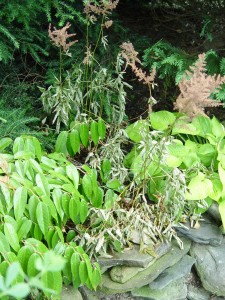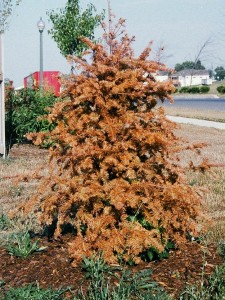Heat-Busting in the Landscape
July 25th, 2011
At least we’ve got air-conditioning.
Pity the poor landscape plants, out there panting day after day in the brutal heat, searing sun and hot, dusty earth.
This is punishing weather for a landscape – especially for species that aren’t heat- and drought-hardy and for anything that’s been planted in the last year or two.
Highs near 100 degrees take a toll.
Water demands go way up, soil moisture goes way down, and plants shift from a healthy growth mode into hang-on-for-dear-life mode.
You might be seeing signs of that already.
Wilting is the best known. When a plant can’t move enough moisture from roots to leaves, the leaves go limp like the look on a toddler’s face when the day’s over at Hersheypark.
It just looks sad.
The antidote is water. A good soaking, too, not one of those 5-second sprinklings that merely wet the leaves.
The best time to water a wilted plant is yesterday. Second best is ASAP, before the wilting advances into tissue death.
Usually the first thing to go in heat or drought is the tips and margins of plant leaves.
A subtle discoloring into a pale green or yellowish green is the early phase, followed by browning around the edges that works its way into the heart of the leaves.
That’s a plant’s way of telling you, “Hey, I need water RIGHT NOW, and if I don’t get it soon, we’re both going to be sorry.”
Some plants survive by going to sleep in a heat wave or by dropping some or even all of their leaves. That makes biological sense since leaves are the main way plants lose moisture.
So if you see some of your trees and shrubs shedding leaves, that’s not necessarily doomsday. It’s not ideal for a dogwood or birch to defoliate only halfway through a growing season, but if it helps the plant survive, it’s better than the alternative.
Perennials such as astilbe and sweet woodruff may fry back to the ground in a hot, dry summer, but they almost always bounce back, too, when the weather is more amenable.
Tulips, bleeding hearts, Virginia bluebells and alliums are all good examples of plants smart enough to hibernate every summer. They do their thing in spring, then die back and stay dormant until early the following spring.
Needled evergreens are a different story.
If you see any of your junipers, spruce, hemlocks, pines, arborvitae, etc. going completely brown, they’re almost certainly dead.
Sometimes evergreens will give you a warning with browning needle tips, but often the first sign of trouble is when the whole thing seems to go brown overnight.
In that scenario, the plant actually died weeks ago, but it took that long for the needles to lose enough moisture to discolor. Once an evergreen crosses the line from stressed to root death, all the water in DeHart Dam won’t save it – even if it still has green needles.
Wait until fall or even next spring to think about replacing dead plants. Now’s not the time for that.
Lawns are adapted enough to withstand weeks of this brutal summer heat and drought.
It’s actually normal and advantageous for lawns to go brown. New growth stops, and that ratchets down water demand, which in turn conserves moisture in the roots.
Lawns can stay brown and dormant for 4 to 6 weeks in summer and green up just fine when a soaking rain finally happens.
Beyond that and it’s probably best to give a lawn about one-quarter of an inch of irrigation per week – enough to keep the roots alive without triggering the grass back into growth mode.
The X factor is that flat-out high heat is enough to kill some grass species, such as wimpier varieties of perennial ryegrass. Many area home-owners found that out after last year’s 100-degree spell.
Temperatures that high threaten some grass life. Especially at risk are new lawns (ones planted in the last two years) and grass along heat-absorbing asphalt and next to roads and walks where it may have absorbed rock-salt run-off from winter de-icing.
Also at risk: grass that’s been scalped and grass planted on lousy, compacted clay soil.
The best things you can do for your lawn in this weather are to stay off it; don’t cut it; don’t put down any fertilizer, and if you fall into any of the above risk categories, do that weekly life-salvaging quarter-inch watering.
Give watering priority to recently planted shrubs and trees – basically, the highest-value stuff that’s most at risk because of limited roots.
Weekly or twice-weekly deep soakings are far better than nightly light sprinklings.
Remember, the goal is to wet the soil down to the bottom of the roots. Just wetting the mulch or the leaves does no good.
The two best times to water are early morning and early evening. That avoids high-evaporation midday hours while giving plant leaves the best timing to dry off. (Wet leaves can lead to disease, which is why after-dark watering isn’t good.)
Better yet, water directly into the ground and not over top of your plants at all.
If you must prune in this oven called July, give your plants a good, deep soaking after doing the deed.
And then pray we’ll get a few good rains, preferably without the tornados, hail and branch-breaking wind.
All of our buckets, hoses, Watering Wands and drip systems don’t add up to the value of one, good-old daylong soaking.










